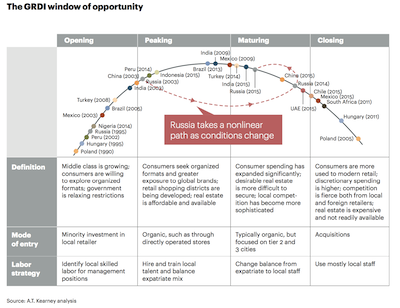 Gucci campaign image with Li Bing Bing
Gucci campaign image with Li Bing Bing
By 2022, China’s retail market is expected to be double that of the United States and grow to $8 trillion, according to a new report by A.T. Kearney.
Although Asia, considered by the “Global Retail Development Index Ranking” as a regional winner for 2015, has slowed in growth over the last few years, the region still outpaced other emerging markets. The markets typically associated with retail expansion remain attractive for luxury brands looking to extend their bricks-and-mortar presence, especially as they become more developed.
"To enter emerging markets successfully, luxury brands must really get into the details of local market dynamics,” said Jodie Wang Kassack, co-author of the report and manager, retail practice at A.T. Kearney, New York. “The entry strategy for the United Arab Emirates, where 98 percent of brands are franchised, is very different from that of India which now allows 100 percent FDI in single brand retail."
Published since 2001, A.T. Kearney’s Global Retail Development Index Ranking (GRDI) ranks the top 30 countries for retail investment worldwide. The GRDI analyzes 25 macroeconomic and retail-specific variables to help retailers devise successful global strategies to identify emerging market investment opportunities.
For 2015, the GRDI includes an analysis of the 15 leading luxury brands and their retail presence in the report’s top 30 countries.
Where in the world
The global retail landscape has transformed as emerging markets become more stable, and the consumers living in those regions have evolved to become sophisticated and conscious shoppers. With each market, a new challenge is presented due to the unique economic climate and consumer patterns which force retailers to curate consumer experiences based on region, rather than taking a global approach.
A.T. Kearney’s GRDI found that in the last year retailers focused on the larger picture of developing markets and did not abandon troubled regions. For example, retailers with a footprint in the Middle East and Latin America were cautious in their approach, but only a few exited turbulent markets.
Despite economic and social issues plaguing many emerging markets, luxury remains a “bright spot.” This is due to wealthy individuals being less vulnerable to economic troubles than the general public, as well as the development of malls catering to consumers with disposable income who are increasingly mobile.
 In Asia, luxury brands continue to enter markets at a steady pace. This has been especially true in the development of modern retail in tier 2 cities that have traditionally been void of luxury brands.
Ecommerce in Asian markets have also been constructive to the region’s growth. Asia’s ecommerce market size is now $525 billion, passing North American which generates $483 billion in online sales. Going forward, Asia’s ecommerce retail sales may grow as much as 25 percent per year.
By country, China holds the number one spot in the GRDI for the first time in five years, while smaller nations such as Mongolia and Malaysia made it to the top 10. Although growth is noted elsewhere in Asia, China’s position on the top of the list is due the country’s retail growth of 11.6 percent.
Countries in the Middle East have faced significant economic and political strife, but despite a drop in oil prices, the area's most profitable export, retail growth is expected to continue. The GRDI found that the Middle East’s “retail space pipeline” remains strong with projects breaking ground in Qatar, United Arab Emirates and Oman.
In Asia, luxury brands continue to enter markets at a steady pace. This has been especially true in the development of modern retail in tier 2 cities that have traditionally been void of luxury brands.
Ecommerce in Asian markets have also been constructive to the region’s growth. Asia’s ecommerce market size is now $525 billion, passing North American which generates $483 billion in online sales. Going forward, Asia’s ecommerce retail sales may grow as much as 25 percent per year.
By country, China holds the number one spot in the GRDI for the first time in five years, while smaller nations such as Mongolia and Malaysia made it to the top 10. Although growth is noted elsewhere in Asia, China’s position on the top of the list is due the country’s retail growth of 11.6 percent.
Countries in the Middle East have faced significant economic and political strife, but despite a drop in oil prices, the area's most profitable export, retail growth is expected to continue. The GRDI found that the Middle East’s “retail space pipeline” remains strong with projects breaking ground in Qatar, United Arab Emirates and Oman.
 Burberry Beauty Box in Seoul
Qatar debuted on the GRDI for the first time at number four due to its stable economy, high GDP per capita and high levels of retail spending. Qatar is expected to continue to prosper due to a growing population and infrastructure updates, including airport expansion, as the country plans to host the 2022 FIFA World Cup.
Nearby in Central Asia and Eastern Europe, smaller markets such as Georgia, Armenia and Kazakhstan performed well on the GRDI because of “unsaturated retail environments” that have formed attractive opportunities for retailers. Azerbaijan has become a luxury hot spot recently while Russia, which has the world’s sixth largest GDP, drops in the ratings due to economic woes and political tensions.
Though Russia faces difficulties socially, politically and economically, the country remains too large for brands and retailers to ignore.
Similarly, Latin America has faced concerns due to poor economic performance and political instability in some of the market’s leading countries. But, the region as a whole has a strong hold in the GRDI with three countries in the top 10: Uruguay, Chile and Brazil.
Although Brazil has not been as fruitful as retailers had hoped, second tier cities in the country, as well as in neighboring Colombia and Peru, offer benefits to brands entering the region.
Burberry Beauty Box in Seoul
Qatar debuted on the GRDI for the first time at number four due to its stable economy, high GDP per capita and high levels of retail spending. Qatar is expected to continue to prosper due to a growing population and infrastructure updates, including airport expansion, as the country plans to host the 2022 FIFA World Cup.
Nearby in Central Asia and Eastern Europe, smaller markets such as Georgia, Armenia and Kazakhstan performed well on the GRDI because of “unsaturated retail environments” that have formed attractive opportunities for retailers. Azerbaijan has become a luxury hot spot recently while Russia, which has the world’s sixth largest GDP, drops in the ratings due to economic woes and political tensions.
Though Russia faces difficulties socially, politically and economically, the country remains too large for brands and retailers to ignore.
Similarly, Latin America has faced concerns due to poor economic performance and political instability in some of the market’s leading countries. But, the region as a whole has a strong hold in the GRDI with three countries in the top 10: Uruguay, Chile and Brazil.
Although Brazil has not been as fruitful as retailers had hoped, second tier cities in the country, as well as in neighboring Colombia and Peru, offer benefits to brands entering the region.
 Ralph Lauren in Sau Paulo, Brazil
Sub-Saharan Africa, traditionally untapped by luxury retail, also offers massive potential for brand expansion. For 2015, three countries, Botswana, Nigeria and Angola, were ranked in the top 30 of the GRDI while three others, Zambia, Namibia and Ghana, are expected to enter in the near future.
The region is expected to be worthwhile for retailers as supported by rising household incomes, fast urbanization and a growing middle class. The report suggests that by 2040, Sub-Saharan Africa will be the “big story” after a “bumpy road to get there.”
Expanding thoughts
When entering a new market there are challenges as each consumer demographic behaves differently and the approach to luxury products varies.
The luxury sector is continuing to evolve with the majority of affluent consumers recognizing that the definition of luxury is not what it was five years ago, according to a report by Martini Media.
As consumers’ tastes have changed from exclusive or status-oriented products to an interest in rare experiences, the Internet has been a driving factor in how these individuals make decisions regarding purchases and bookings. Marketers have invested heavily in digital marketing to account for this trend and to provide consumers with content geared toward ensuring informative purchases (see story).
As with consumers, the market itself also requires strategies to be skewed toward specific wants and needs.
“Beyond ownership, markets also differ widely in consumer tastes, real estate availability, infrastructure, duties and taxes and marketing channels, among many other things,” Ms. Wang Kassack said.
“Getting a firm grasp on these local differences really makes a difference,” she said. “It is also crucial for brands to develop a market strategy with the long-term in mind. In many cases, initial success in a market can spur quick-fire expansion, with the risk of over extending the brand.”
Final Take
Jen King, lead reporter on Luxury Daily, New York
Ralph Lauren in Sau Paulo, Brazil
Sub-Saharan Africa, traditionally untapped by luxury retail, also offers massive potential for brand expansion. For 2015, three countries, Botswana, Nigeria and Angola, were ranked in the top 30 of the GRDI while three others, Zambia, Namibia and Ghana, are expected to enter in the near future.
The region is expected to be worthwhile for retailers as supported by rising household incomes, fast urbanization and a growing middle class. The report suggests that by 2040, Sub-Saharan Africa will be the “big story” after a “bumpy road to get there.”
Expanding thoughts
When entering a new market there are challenges as each consumer demographic behaves differently and the approach to luxury products varies.
The luxury sector is continuing to evolve with the majority of affluent consumers recognizing that the definition of luxury is not what it was five years ago, according to a report by Martini Media.
As consumers’ tastes have changed from exclusive or status-oriented products to an interest in rare experiences, the Internet has been a driving factor in how these individuals make decisions regarding purchases and bookings. Marketers have invested heavily in digital marketing to account for this trend and to provide consumers with content geared toward ensuring informative purchases (see story).
As with consumers, the market itself also requires strategies to be skewed toward specific wants and needs.
“Beyond ownership, markets also differ widely in consumer tastes, real estate availability, infrastructure, duties and taxes and marketing channels, among many other things,” Ms. Wang Kassack said.
“Getting a firm grasp on these local differences really makes a difference,” she said. “It is also crucial for brands to develop a market strategy with the long-term in mind. In many cases, initial success in a market can spur quick-fire expansion, with the risk of over extending the brand.”
Final Take
Jen King, lead reporter on Luxury Daily, New York
